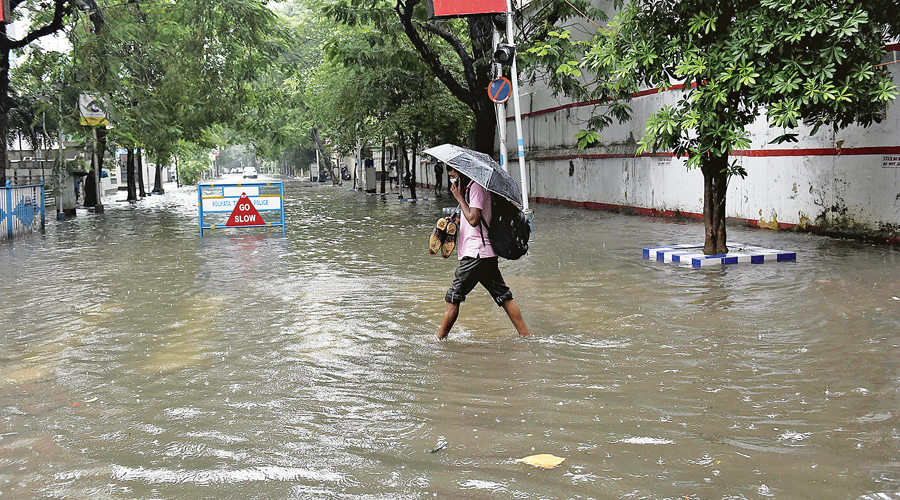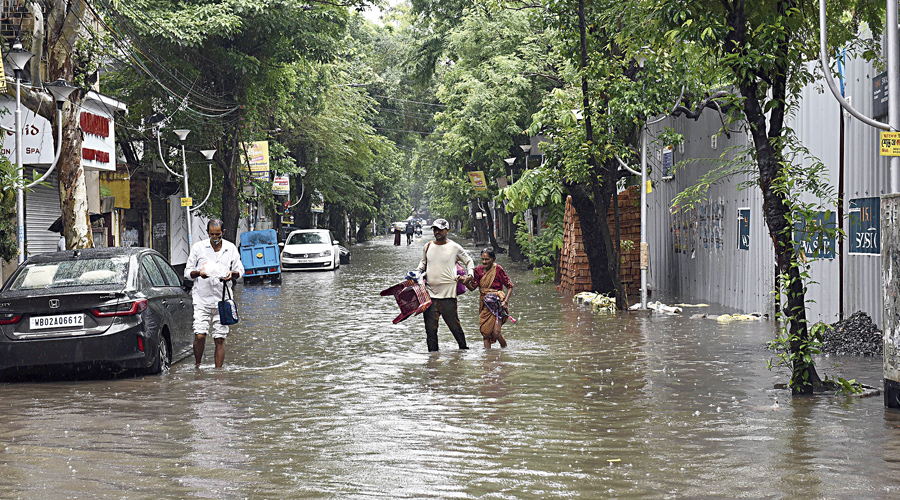Torrential rain and high tide, which prevented water from being drained out into rivers, led to widespread flooding across the city on Thursday, engineers of the Calcutta Municipal Corporation said.
Ten drainage pumping stations in the city recorded over 100mm of rain from 10pm on Wednesday till 6am on Thursday. Five of them recorded over 150mm of rain during the period.
Data shared by the Calcutta Municipal Corporation (CMC) showed that the Mominpore drainage pumping station recorded 179mm of rain, Kalighat drainage pumping station 168.2mm, Behala Flying Club station 163.6mm,
Topsia station 153mm and the Chetla Lockgate station 150mm.
Almost the entire Calcutta was inundated when dawn broke on Thursday because of intense rain overnight.

A waterlogged Theatre Road on Thursday afternoon. Picture by Gautam Bose
Central Avenue, Colootolla, Park Street, JL Nehru Road, Camac Street, Queens Park, Lake Gardens, Southern Avenue and Kasba were among the worst-hit.
Some of the city pockets that usually do not see waterlogging, such as Loudon Street and Rawdon Street, were flooded on Thursday.
An engineer blamed the widespread waterlogging to high volume of rain at night and high tide the next morning, which did not let water flow into the Hooghly and Bidyadhari rivers.
“The city got maximum rain from 10pm on Wednesday to 4am on Thursday. We were able to drain out a lot of water as the Hooghly gates remained open till 4am. It was closed at 4am and again opened at 8am. The gates were again close between 4.30pm and 8.30pm,” said Tarak Singh, a member of the CMC’s board of administrators who heads the drainage department.
But the volume of rainfall far surpassed the capacity to drain out water. Calcutta’s underground drainage network is designed to prevent any waterlogging only if it rains up to 6mm in an hour, said an engineer.

A flooded Lake Gardens on Thursday afternoon. Picture by Bishwarup Dutta
The capacity is increased by installing more pumps. “Water could not be drained out after 4am. Also, more rain added to the volume of accumulated water. Water was drained out from most of the roads by the afternoon,” Singh said.
Accumulated rainwater in the city flows out naturally to the west into the Hooghly and to the east into the Bidyadhari after passing through drainage pumping stations.
The sluice gates through which water passes into the rivers had to be closed for several hours on Thursday as the water levels in the rivers were too high because of the rain and high tide.
“Whenever there is heavy rain, the Hooghly sluice gates are opened so that some of the rainwater is drained out into the river. This helps reduce the burden on the drainage pumping stations. It becomes a problem when heavy rain coincides with high tide,” the engineer said.

Loudon Street Picture by Bishwarup Dutta
“During high tide, the level of the water in the Hooghly is higher than the level of the drainage lines. If the sluice gates are kept open, water from the Hooghly will flow back into the drainage network and only worsen the waterlogging. That is why the sluice gates have to be kept closed when there is high tide in the Hooghly.”
A similar system is followed in operating the Bidhyadhari river sluice gates.
Singh said that if it did not rain at night, the remaining water would be drained out by the morning.
“Most of the water receded by the afternoon. Some of the places were waterlogged till the evening probably because of other issues like blocked drains,” he said.
Some gully pits were blocked with plastic and polythene bags, further slowing down draining out of water.
In Behala, waterlogging was blamed on the civic body’s inability to run the drainage pumping station at Behala Flying Club. Singh said people living along a canal in which the pumping station discharges water protested, saying water from the canal was entering their houses.
“We hope we will be able to operate the pumps at the station soon,” Singh said on Thursday evening.










